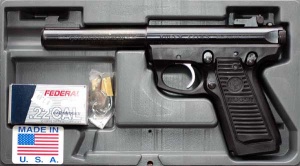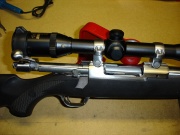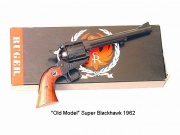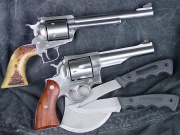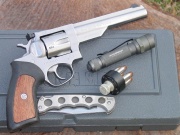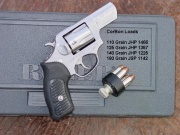Sturm, Ruger
| ||||||||||||||||||||||||
Sturm, Ruger & Company, Incorporated is a Fairfield, Connecticut-based firearm manufacturing company, better known as just 'Ruger'. Sturm, Ruger produces bolt-action, semi-automatic, full-automatic, and single-shot rifles; shotguns; semi-automatic pistols; and single-action and double-action revolvers.
Contents |
[edit] History
Sturm, Ruger & Company was founded by William B. Ruger and Alexander McCormick Sturm in 1949 in a small rented machine shop in Southport, Connecticut. Just prior to their partnership, Bill Ruger had successfully duplicated two Baby Nambu pistols [1] in his garage, from a captured Nambu that he acquired from a returning US Marine, at the close of WWII. Although deciding against marketing the Nambu pistols, he incorporated the Nambu's rear style cocking device and a modified Nambu's silhouette into their first commercially produced .22 caliber pistol (see Ruger MK II), which became so successful that it launched the entire company. Ruger firearms is the nations fourth largest firearms manufacturer,[2] and the only one producing firearms in all four market segments: rifles, shotguns, pistols, and revolvers.
Ruger is a dominant player in the .22 rimfire rifle market in the U.S. with its Ruger 10/22. The 10/22 is popular due to being relatively inexpensive and of good quality as well as the wealth of aftermarket accessories and parts available for it. In fact, it's possible to build a 10/22 using only aftermarket parts, several of which are marketed to target shooters at prices starting at approximatley $1000.Ruger similarly dominates the .22 rimfire semiauto pistol market with the Ruger MK II and Ruger MK III. Like the 10/22, the MkII is extremely well supported with a variety of good aftermarket accessories.
Ruger Casting has plants in Newport, New Hampshire and Prescott, Arizona, making ferrous, ductile iron and commercial titanium castings. Ruger Golf makes steel and titanium castings for golf clubs made by a number of different brands.
Sturm, Ruger stock has been publicly traded since 1969, and became a New York Stock Exchange company in 1990 (NYSE:RGR). After Alex Sturm’s death in 1951. William B. Ruger continued to direct the company until his death in 2002.
From 1949 through 2004, Ruger manufactured over 20 million firearms, and currently offers hundreds of models for hunting, target shooting, self-defense, collecting, and law enforcement.
[edit] Corporate governance
Current (2006) members of the board of directors of the company are: [3]
- Michael O. Fifer (49) Chief Executive Officer
- Stephen L. Sanetti (57) Vice Chairman of the Board of Directors, President, and General Counsel
- Thomas A. Dineen (38) Vice President, Treasurer and Chief Financial Officer
- Robert R. Stutler (63) Vice President of Prescott Operations
- Thomas P. Sullivan (46) Vice President of Newport Operations
- Christopher J. Killoy (48) Vice President of Sales and Marketing
- Leslie M. Gasper (53) Corporate Secretary
[edit] Products
Ruger breaks down their products into four main categories: [3] rifles, shotguns, pistols, and revolvers.
[edit] Rifles
- Ruger No. 1
- Ruger M77
- Mini-14
- Ruger Police Carbine
- Ruger Deerfield Autoloader (discontinued) [4]
- Ruger 96 (discontinued)
- Ruger 10/22
The Ruger M77 Mark II rifle uses a modified version of the Mauser 98 action. This is a controlled round feed action. During the '90s, Ruger M77 rifles garnered a reputation for not being particularly accurate. Ruger addressed this problem in the early 2000's by producing their own hammer-forged barrels. Prior to this, they procured barrels from various manufacturers and have admitted that the quality was not as good as what they are now producing.
Recent examples of Ruger M77 Mark II rifles have been well regarded by Gun Tests magazine (2002,2004).
[edit] Submachine guns
[edit] Pistols
- P85 (discontinued)
- P89
- P90
- P91 (discontinued)
- P93 (discontinued)
- P94 (discontinued)
- P944
- P95
- P97 (discontinued)
- P345
- SR9
- LCP
- Ruger MK I (discontinued)
- Ruger MK II (discontinued)
- Ruger MK III
- Ruger Charger
[edit] Revolvers
- GP-100
- SP-101
- Ruger Redhawk
- Super Redhawk
- Security Six (discontinued)
- Service Six (discontinued)
- Speed Six (discontinued)
- Ruger Old Army (discontinued)
[edit] Shotguns
[edit] Controversy
After a spate of high profile shootings and incidents with the Ruger Mini-14 rifle, along with the popularity the Mini 14 had gained with militias and extremist movements during the late 1970s and 1980s, William B. Ruger expressed a highly unpopular position (amongst firearms owners, users and enthusiasts) by stating his personal views on the "sporting" nature of certain firearms. In his letter to members of the House and Senate on 30 March 1989, Mr. Ruger stated (in what has come to be known as "The Ruger Letter"):
"The best way to address the firepower concern is therefore not to try to outlaw or license many millions of older and perfectly legitimate firearms (which would be a licensing effort of staggering proportions) but to prohibit the possession of high capacity magazines. By a simple, complete, and unequivocal ban on large capacity magazines, all the difficulty of defining "assault rifles" and "semi-automatic rifles" is eliminated. The large capacity magazine itself, separate or attached to the firearm, becomes the prohibited item. A single amendment to Federal firearms laws could prohibit their possession or sale and would effectively implement these objectives."
In addition to the furor amongst hunters, sportsmen and shooters caused by "The Ruger Letter", Mr. Ruger made additional comments during an interview with NBC network's Tom Brokaw that angered 2nd Amendment supporters further, saying: "no honest man needs more than 10 rounds in any gun…" and "I never meant for simple civilians to have my 20 and 30 round magazines…". It has long been Ruger's policy to limit sales of those items to Law Enforcement or Military purchasers.
This position, coming from an important firearms manufacturer such as Mr. Ruger, caused outrage in the shooting sports community and led some to boycott Ruger's products.
"The Ruger Letter" is widely believed to be the genesis for those parts of legislation that were drafted 5 years later in the now defunct Assault Weapons Ban which prohibited the manufacture of any magazines holding over 10 rounds of ammunition for civilian sale, except to the motion-picture industry, which Ruger continued to pursue. It should be noted, however, that Mr. Ruger actually had advocated a 15 round limit.
Recently Ruger has retreated from its historical position of limiting sales of these magazines to the average citizen. Ruger is now actively selling high capacity 20 round magazines in a 2008 promotion for their Mini-14 semi-automatic rifles.
[edit] See also
[edit] References
- ↑ Wilson, R. L. "Ruger & His Guns; A History Of The Man, The Company And Their Firearms." 1996. ISBN-10: 07-8582-1031.
- ↑ BATFE Annual Firearms Manufacturing And Export Report
- ↑ Cite error: Invalid
<ref>tag; no text was provided for refs named10k - ↑ Gallery of Guns - Shooting Times - Gun Reviews

